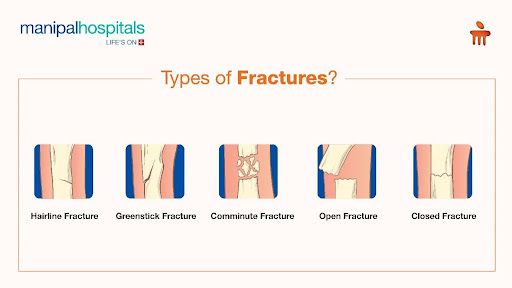
Bones give shape to our body. It provides support, the framework for movement and protects our vital organs. But just like any other structure, bones can be susceptible to damage under pressure. Broken bones, medically known as fractures are a prevalent injury. These injuries pose significant challenges to daily activities. However, with the right knowledge, we can treat this condition. Let’s explore the types, healing processes and treatment procedures aimed at restoring mobility and well-being.
Synopsis
Understanding Fractures and Broken Bones
Fractures occur when force applied to a bone exceeds its ability to withstand it. This force can come from a sudden impact like a fall, accident, or sports injury. It can also occur due to repetitive stress caused by activities like running. Children, whose bones are still growing and developing, are particularly susceptible to greenstick fractures. These incomplete fractures occur when the bone bends and cracks on one side without breaking completely. Age-related bone weakening, such as osteoporosis, also increases fracture risk in adults. It is important to note that symptoms of fractures vary depending on their severity and location. They may include bruising, swelling, pain, deformity, and difficulty moving.
What are the Types of Fractures?

Not all fractures are created equal. They come in various forms, each with its characteristics.
Bone fractures manifest in various forms. Each type requires specific treatment approaches. Some of the common types of broken bone or fractures may include:
-
Stress Fracture: A thin crack in the bone, often caused by repetitive stress. These are commonly seen bone fracture type in the foot and lower leg due to activities like running or jumping.
-
Greenstick Fracture: As mentioned earlier, this incomplete fracture is more prevalent in children's flexible bones. The bone bends and cracks on one side but remains partially intact.
-
Comminuted/ Multifragmentary Fracture: This complex fracture results in the bone breaking into multiple fragments, typically caused by high-energy injuries like car accidents.
-
Open Fracture: When the broken bone pierces the skin at the fracture site and protrudes through skin breakage, it's termed an open fracture. This type of fracture carries a higher risk of infection and requires immediate medical attention.
-
Closed Fracture: When the broken bone doesn't pierce and breaks the skin, making it less severe compared to an open fracture.
The Healing Process of Fractures
The human body is remarkably resilient, and fractures have a natural healing process. Here's a simplified breakdown:
-
Inflammation: Immediately after the fracture, the body triggers an inflammatory response to control bleeding and initiate healing.
-
Callus Formation: The body forms a soft "callus" of cartilage and blood vessels around the fracture site, bridging the broken ends.
-
Bone Formation: Over time, the cartilage callus is gradually replaced by new bone tissue, forming a stronger bond at the fracture site.
-
Remodelling: In the final stage, the newly formed bone undergoes remodelling to regain its original shape and strength.
This healing process can take weeks to months, depending on the fracture's severity, location, and overall health of the patient.
Treatments for Broken Bones
Bone fracture treatment is tailored to the specific type and severity. Here are some of the common treatment methods:
-
Immobilization: Casts, splints, or braces are used to immobilize the fractured bone and facilitate proper healing.
-
Reduction: In some cases, it may need to manipulate the broken bone fragments back to their original position. This process is called closed reduction and may be performed under anaesthesia.
-
Surgery: For complex fractures, surgery may be necessary to reduce, align and stabilize the bone fragments using pins, wires, plates, nails, screws and external fixation in case of open fractures.
-
Physical Therapy: After the bone heals sufficiently, physical therapy helps regain strength, flexibility, and range of motion in the affected area.
Visit our best Orthopaedics Doctor in Salt Lake to map out your ideal treatment.
Conclusion
A fracture can be a setback, but with proper treatment, a positive attitude, and active participation of the patient in the recovery, complete healing is achievable. Remember, following your doctor's instructions regarding weight-bearing, medication, and physical therapy is crucial. Maintaining a healthy diet rich in calcium and vitamin D also aids bone healing. Consult our Orthopaedic Hospital in Salt Lake to reach your optimal health condition.
By understanding fractures, and their treatment, and actively participating in the recovery, you can get back to enjoying your life with strong and healthy bones! Check our blog page to learn more about the updates in the medical world.
FAQ's
The healing time varies depending on the fracture type, location, and individual factors. Non-displaced fractures may heal within a few weeks, while complex fractures requiring surgery can take a few weeks to months.
Yes, if you follow medical advice strictly, a stress fracture can heal on its own. While stress fractures may not require casts, splints or braces, excessive stress can impede healing and delay recovery.
If you suspect a fracture, it is advised to seek medical attention promptly. Avoid moving the injured area and apply some first-aid to reduce swelling.



















 4 Min Read
4 Min Read
















